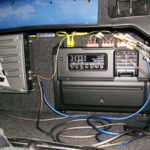Before you read my guide to purchasing a home amplifier ask yourself these questions. Are you sick of listening to those crummy old speakers in your T. V.? Does the baby crying three rooms away drown out the T.V.? If so, what you really need is an amplifier. A home theater amplifier and a few well placed speakers. There are many Amplifiers on the market today but when you google for an amp the first thing you’re likely to come up with is a car amp.
It’s not very typical for the home entertainment center to contain an amplifier. The reality is nearly every good entertainment center has an amp. People just don’t realize it. In those 5.1 speaker systems, what do you think pushes that subwoofer? It’s a built in amp and more often home theater amplifiers are under the guise of receivers. They are called receivers, because they receive the signals from all your other devices. They technically are receivers, but there is a pre-amp built into them which drives those speakers. So in reality a receiver is a home stereo amplifier and a Stereo in one unit.
Moving on you will note that there are so many available receivers these days that it hardly seems easy to pick just one… or you could go with a speaker set with built in amplifier. This would allow you to have one less device under your cabinet. Regardless here are some tips and things to look for when you shop for your amplifier, receiver, or speaker set.
Power rating,
If your amplifier doesn’t provide enough watts, you’re not going to get much sound out of it. “Power = watt”. The first thing you want to look for in your system is how many watts is it? A good amplifier for a mid sized living room is at least “150 watts stereo receiver”, “400 watt 4.1”, “500 watt. 5.1”. You should have an idea how this goes from here. Watch out for hooks. They will catch you by saying it’s a 600 watt system, but what they really mean is 600 watts “MAX” not 600 watt RMS, what’s the difference? 600w RMS is an average of the peak and minimal wattage at max volume. Where as 600 watt max is just that at its peak it can reach 600 watts, but it won’t be able to maintain that.
Number of inputs,
If you don’t have enough inputs you’re going to find you have a problem. When you try to hook your new amp up you’re going to be left with extra devices and nowhere to put them. The next most important thing to inspect at the store or online, is how many inputs it has. You need a compatible input for every device you plan to use on your amplifier.
Sound Quality,
How does it sound? If it sounds bad in the store it’s going to sound worse at home. Best to leave it at the store where you don’t have to listen to it. Don’t dismiss an amp before you have listened to it for a while though either. You may be surprised, try multiple input methods. It could just be a bad or weak radio signal making it sound so bad.
Speakers,
How many speakers come with the Amplifier/receiver? is it 4.1 5.1? Are they good speakers or do they look like they are made from paper? how assorted are their sizes for theater sound you need some tweeters a mid ranged speaker and a subwoofer.
THD,
THD stands for (Total Harmonic Distortion) what this means is it’s a measurement of how much distortion you will hear at varied power levels. A good THD is “0.01%” a bad THD can be as much as “10%”. Watch out for this or you will end up with a lousy sounding amp that has 600W of raw power and sounds like a trash compactor.
Signal to noise ratio,
This is considerably more important for your movies then your music. The signal to noise ratio is a measurement of how well defined sounds are. For instance, you’re watching an action scene and there are explosions in the background. All you really wanted to hear was three words coming out of the lead actors mouth, and after rewinding four times you still didn’t catch them.
In closing be sure that when you pick out your amplifier it’s not based solely on wattage. This would be a big mistake there is no law saying they can’t list 600W on the box even though it’s really 200W, with a max peak of 600W. Many times that’s exactly what the manufacture will do. Pay attention to price as well a 600W system isn’t going to sell for $10 unless it’s bogus. If it sounds too good to be true then it probably is.






